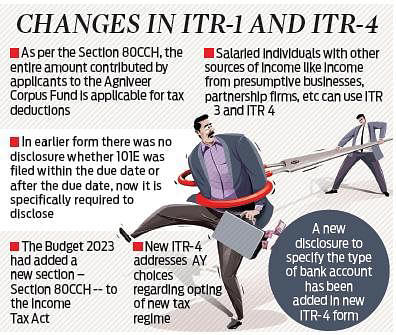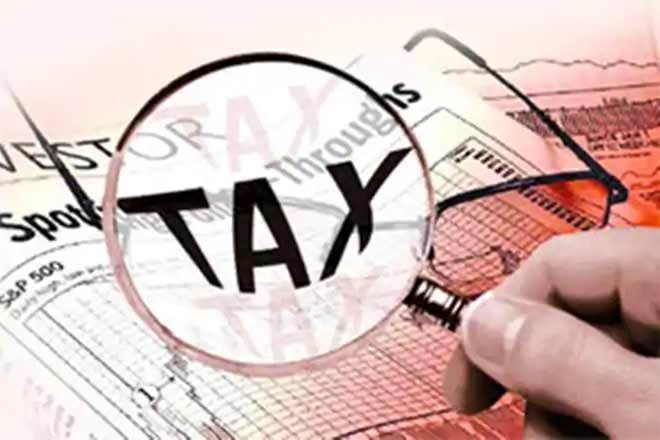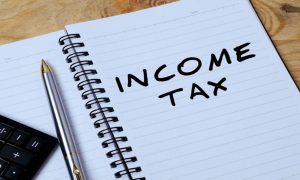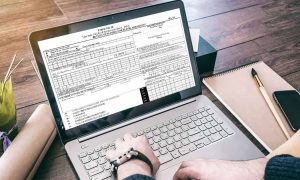new Income Tax Return forms, applicable for assessment year 2024-25, will have a new column for deductions allowed to Agniveers
NEW DELHI: The Income tax department has introduced new Income Tax Return (ITR) Form 1 and ITR Form 4 for assessment year 2024-25.
These ITR forms will be applicable for filing returns in 2024-25 for the income earned during 2023-24.
Usually, the new ITR forms are notified by the I-T department in February and March, but this year the government has notified the changes much in advance. This should help taxpayers familiarise with new disclosures to be made and documents needed to be kept handy. We explain to you the changes (or no changes) made in the ITR forms for the new assessment year.
Read More: All about deadlines to file updated, revised ITR for FY23, change Aadhaar details. Check here
No Change in applicability
The applicability of ITR forms to different classes of taxpayers remains unchanged. ITR Form 1 will apply to salaried individuals with income (or loss) from one house property, family pension, etc.
ITR Form applies to salaried individuals with other sources of income like capital gains from investments, dividend income, income (or loss) from more than one house property, etc. Salaried individuals with other sources of income like income from presumptive businesses, partnership firms, etc can use ITR 3 and ITR 4.
Deduction for Agniveers
The Budget 2023 had added a new section – Section 80CCH — to the Income Tax Act. As per Section 80CCH, the entire amount contributed by applicants and the Central Government to the Agniveer Corpus Fund is applicable for tax deductions. ITR 1 and ITR 4 have been amended to include a column for furnishing details of the deduction amount allowed under this section.
Read More: Govt notifies Income Tax Return forms 1, 4 for assessment year 2024-25
Disclosure for type of account
A new disclosure to specify the type of bank account has been added to the new ITR-4 form. The assessee will have to disclose details of all bank accounts held in India at any time during the previous year (excluding dormant accounts).
Receipts in cash disclosure
A new disclosure to specify the receipts in cash has been added to the new ITR-4 Form. Earlier, no specific column for cash was there, now a specific column has been separated from any other mode, such as Cryptocurrency, etc.
According to Om Rajpurohit, joint partner (Corporate & International Tax) with AMRG & Associate, in the past, all receipts—aside from bank accounts—were disclosed collectively.“Now, the business receipt, which might be in the form of exchange, cryptocurrency, amenities, etc., cannot be combined with cash because of this distinct column for cash receipts. However, it’s unclear how this separate disclosure of cash receipt will be used in the future even when the taxpayer is opting for the presumed tax regime,” he said.
Read More: Sahaj and Sugam Revisions: Indian Taxpayers Face New Disclosures In ITR Forms – Details
New tax regime default option
The Budget 2023 made the new tax regime the default tax regime. When taxpayers go to the income tax portal to file their returns, they see the new tax scheme as a default option. In case they want to file their return under the old regime, they will have to opt for it.
According to tax advisory and services firm Taxman, Section 115BAC (6) allows eligible assesses to opt out of the new tax regime. To exercise this option an assessee with income other than from business and profession must indicate his choice of tax regime in the return form. However, an assessee with income from a business or profession must exercise this option in Form 10-IEA on or before the due date of filing returns.
In the earlier ITR-4 form, there was no disclosure of whether 10IEA was filed within the due date or after the due date, now it is specifically required to disclose. The new ITR 1 and ITR 4 forms have been amended to include these changes.
ITR changes made last year
The changes in ITR forms made last year increased disclosures for taxpayers. Individuals and HUF having business or professional income were required to provide more information regarding opt-in and opt-out of the new tax regime. Such individuals or HUFs were told to make specific disclosures regarding advances from related parties. Some of the changes were basically to plug the gaps that were there in the earlier forms.
For instance, separate schedules for the set-off of current-year capital losses against current-year capital gains income were added for salaried individuals using ITR-2. Specific schedules were made in the returns for disclosing income from Virtual Digital Assets (VDA) such as cryptocurrencies for which a special tax regime was introduced in last year’s budget. The schedule relating to VDA made the intent and interpretation clear that loss suffered on a particular VDA would not be allowed to be offset against the gain from other VDAs.






































